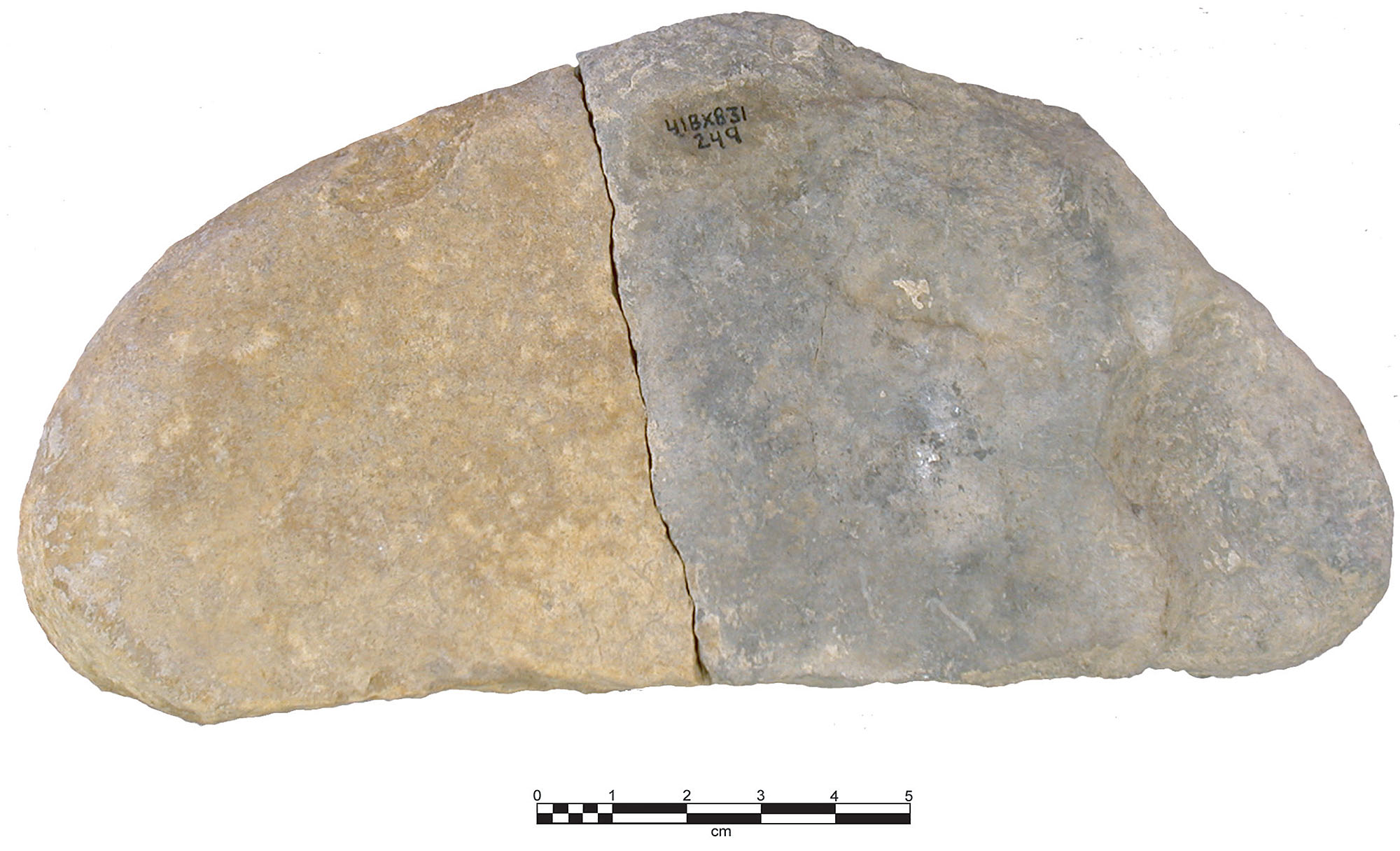
Object: Refitted Grinding Slab
Date: 1000 to 1830 B.C., Late Archaic period
Context: South Texas Plains, Richard Beene site, Upper Leon Creek component, Block B
This stream-worn quartzite slab (measuring approximately 21 x 9 x 3 cm) was probably picked up from a Medina River gravel bar by a hunter-gatherer 3000 years ago, interrupting the stone's disintegrating voyage to the San Antonio River and, eventually, the Gulf of Mexico. At the riverside camp, the stone was used as a grinding slab (or metate)—a hard, smooth surface upon which plant foods were pulverized with the help of a smaller handstone (mano). One day the grinding slab broke in half, perhaps during a particularly vigorous plant-processing event. One half was soon recycled and used as a cooking stone, such as those used in earth oven cooking. The burnt half can be distinguished from the unburnt by its blackened appearance. In 1991, an archeologist excavating at this riverside terrace, the Richard Beene site, found the two halves about five feet apart in adjacent excavation units and realized they refit, as pictured. The refitted stones hold within them two stories—that of a grinding slab and that of a cook stone.
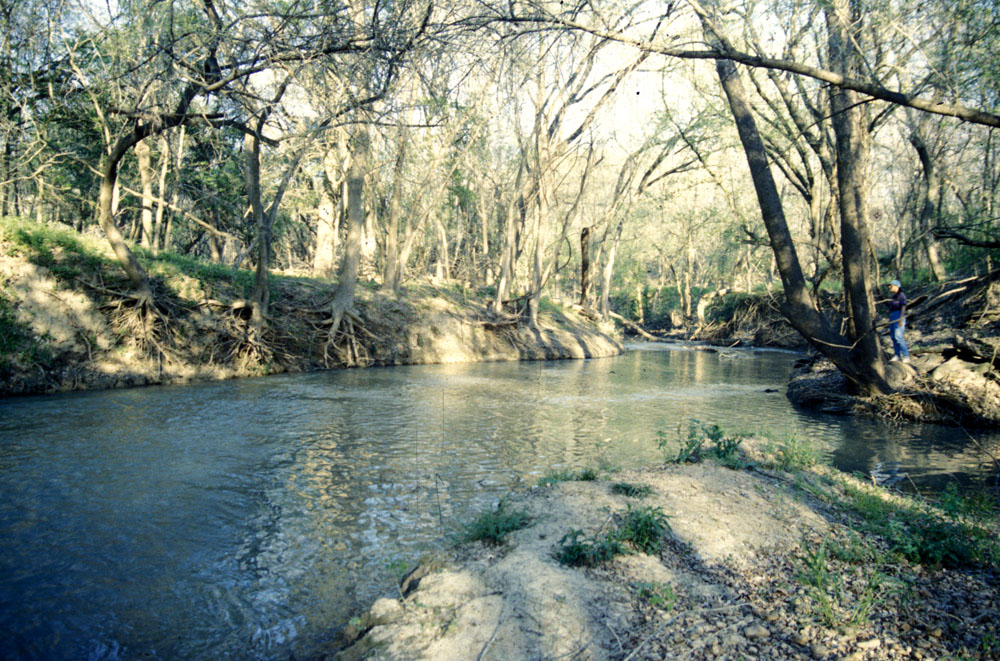
The Richard Beene site is southwest of present-day San Antonio on the broad floodplain of the nearby Medina River. So favorable was the riverside location that the locale was intermittently occupied by people for almost 10,000 years. The natural world provided a plethora of food resources which made the site attractive—prickly pear tunas, pecans and hickory, root foods such as onions, lilies, and false-garlic, as well as deer, small game, fish, freshwater mussels, and turtles. In addition, there was abundant oak, hickory and pecan wood for cooking, chert nodules from the riverbed for making chipped stone tools, quartzite and sandstone for ground stone tools and heating elements in earth ovens.
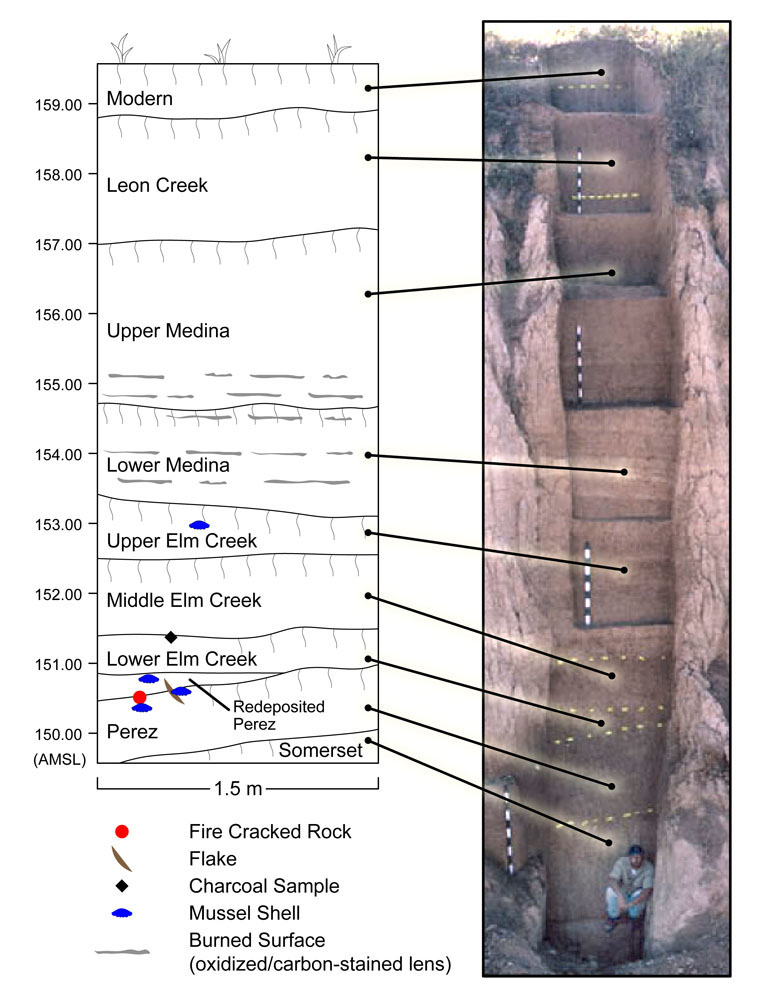
Over time, the river terrace on which the Richard Beene site is situated became higher as sediments were deposited during flooding of the wild Medina River. These muddy sediments settled on top of the archeological debris from past encampments, layer after layer, ultimately burying the earliest cultural deposits under 45 feet of overbank. In total, nine archeological components, representing accumulations spanning hundreds or thousands of years and sometimes containing evidence of multiple occupation episodes, were sandwiched between the flood sediments. The grinding slab pictured here was found in the upper deposits—about three feet below ground surface, in a component called Upper Leon Creek, radiocarbon dated to between 1000-1830 B.C., or about 3,000 to 3,830 years ago.
This was the only grinding slab found in the Upper Leon Creek component, and one of only two slabs found at the site. Grinding slabs are characterized by their shape—usually tabular (thin and flat), with a smooth and sometimes concave area on the worked surface which held food or other materials to be ground. Despite the scarcity of grinding tools found at the Richard Beene site, they were important tools for hunter-gatherers in south and central Texas. They were typically used to process (pulverize) plant materials such as seeds, nuts, roots, and medicinal plants. However, grinding stones may have been used to process other materials as well, including minerals, such as ocher, and even dried meat.
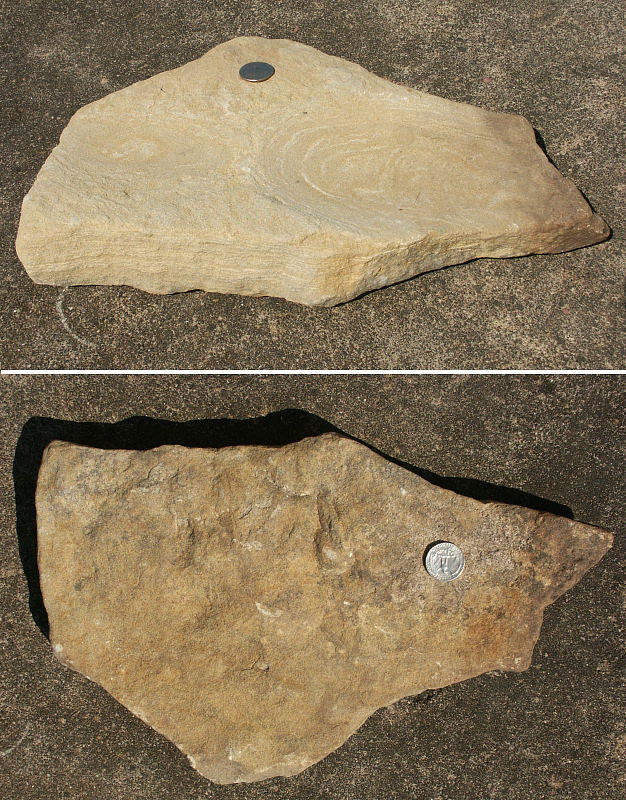
Archeologists use different methods to learn about the function of ground stone artifacts. Information such as wear patterns (striations and polish) and size and shape of the slab and grinding surface can indicate how an artifact may have used. Residue of the processed material can sometimes be sampled from the ground surfaces, directly informing what material(s) were procced on the artifact. Additionally, ethnographic studies sometimes indicate how ground stone artifacts were traditionally used in a particular region. While the Richard Beene grinding slab has not been analyzed for its particular use, the potential for these kinds of study remains; the artifact is curated at Texas A&M University.
Though ground stone was scarce at the Richard Beene site, cook stone was common. The lead archeologist at the Richard Beene site, Alston Thoms of Texas A&M University, identified nine thermal cooking features in the Upper Leon Creek component. These included cooking pits with fire-cracked rock (FCR), oxidized lenses of sediment, dense concentrations of FCR, and thin sheet deposits of FCR. The grinding slab fragments were found in this latter category—an area of scattered FCR called a sheet midden.
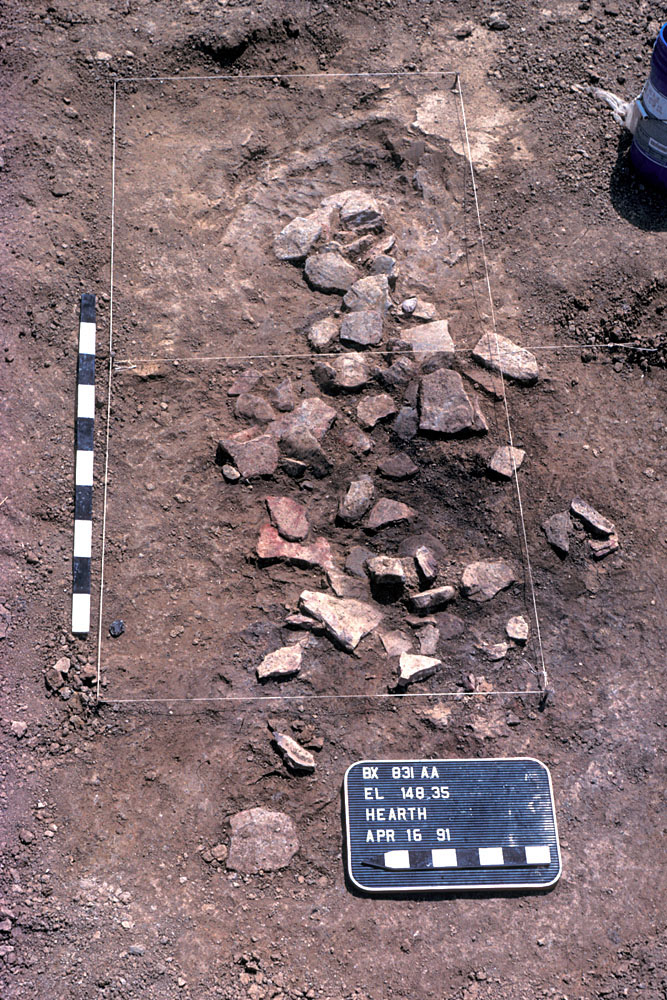
What, you might be thinking, is fire-cracked rock? Also sometimes called burned rock or cook stone, it is rock which bears physical evidence of thermal alteration, including fissuring, cracking, and color change. FCR is generated by earth oven baking (in which heated rocks and foodstuffs are buried together), stone boiling (in which heated rocks are added to a pit or vessel containing water and foodstuffs), or cooking on a hot rock griddle. The most archeologically visible of these hot rock cooking methods is earth oven plant baking, which requires many heated rocks. As the rocks are heated they become thermally stressed and the cook stone breaks down into FCR, becoming too small to store much heat, and are discarded. Sizeable accumulations of FCR are called burned rock middens.
At the Richard Beene site, three different types of rock were used as cooking stones: sandstone, limestone, and quartzite. Sandstone constituted the vast majority of cook stone at the site, likely because sandstone outcrops were abundant in the immediate area. Experiments using sandstone, limestone, and quartzite revealed that sandstone does not hold heat as well as limestone or quartzite and breaks down more rapidly when heated to high temperatures. Limestone and quartzite, on the other hand, can sometimes withstand multiple firing events before cracking.
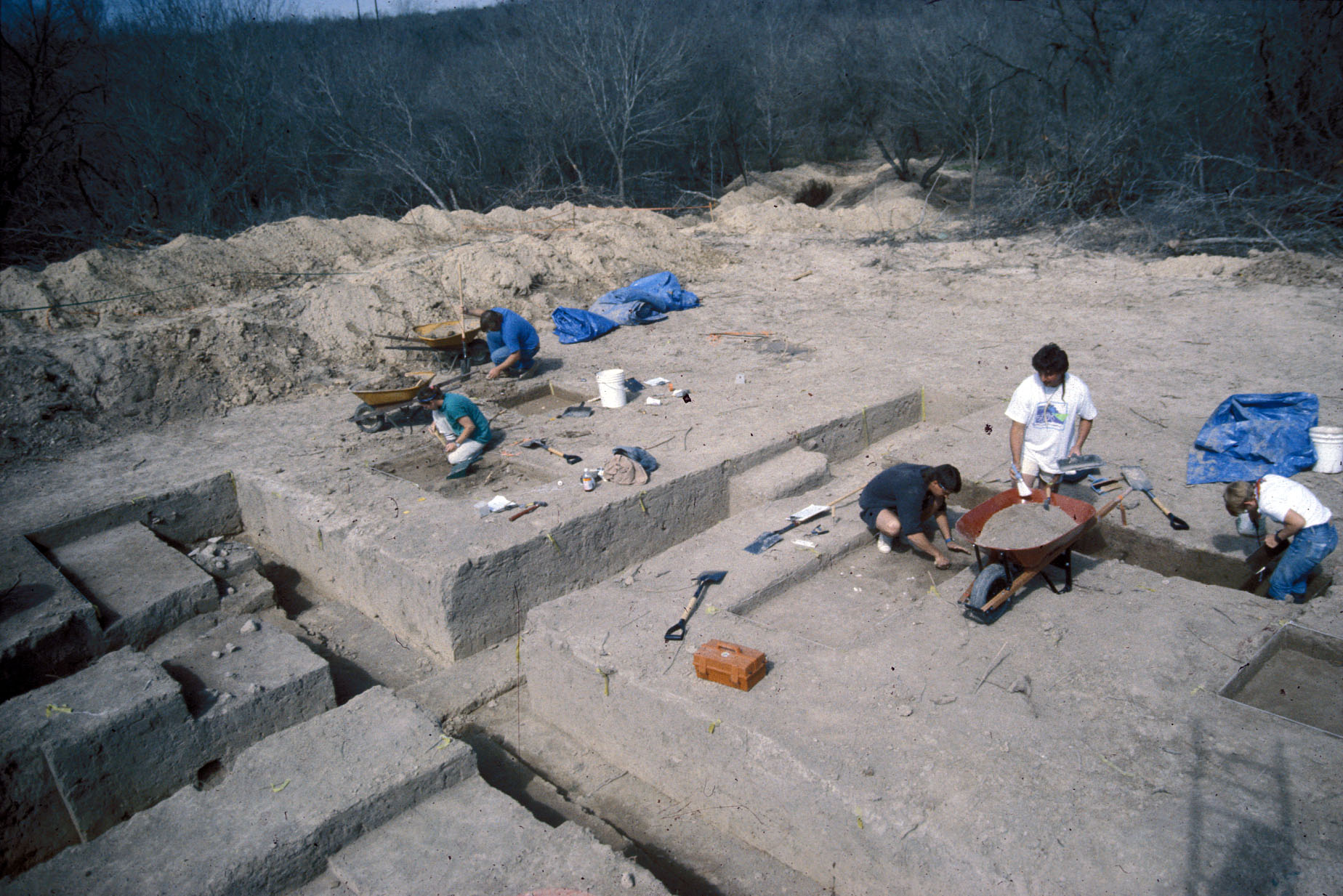
The sheet midden within which this broken grinding slab was found is comprised of burned rock, almost all of which was sandstone, mussel shell, gastropods (land snails) and other debris. The low density of this sheet midden, when compared to burned rock middens found elsewhere on the site and across Central and Southwest Texas, leads archeologists to believe it resulted from a short-duration camp used by just a few families.
The climate of the Late Archaic period, which encompasses the Upper Leon Creek component, is believed to have been somewhat hotter and drier then today. The arid environment likely made this riverine setting all the more attractive, and probably also affected the availability of plant and animal resources. The Upper Leon Creek component was relatively dense in FCR, compared to earlier and later components excavated at the site, leading archeologists to infer that plants commonly baked in earth ovens, such as roots and bulbs, may have been especially important during that time.
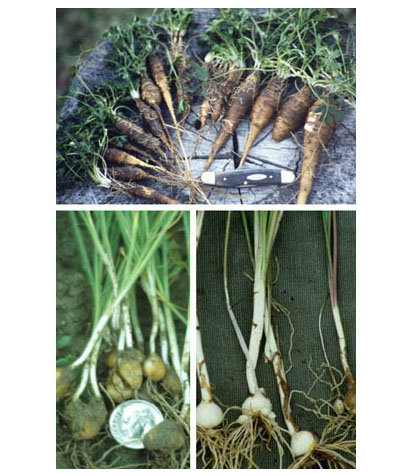
The Richard Beene site was one of many archeological sites identified in the 1980s during the Applewhite Reservoir project. The Applewhite Reservoir was intended to fill the water needs of San Antonio, though the project was never completed. While the Richard Beene site and other area sites were found during archeological testing prior to the construction of the reservoir, it was unknown that other site components were more deeply-buried until dam construction was underway. Project inspector Richard Beene alerted archeologists to the presence of cultural materials he spotted six meters below ground surface and saved the site from oblivion wrought by bulldozer. As work on the dam trench continued, Texas A&M archeologists carried out substantial salvage excavations at the Beene site. In 1991, the citizens of San Antonio voted to halt the Applewhite Reservoir project. The archeologists who excavated at the site and the Tap-Pilam Coahuiltecan Nation worked together with others to create the Land Heritage Institute, a land preserve for research and educational and recreational opportunities, where the reservoir would have been constructed.
The Richard Beene site's refitted grinding slab is a clear example of an artifact with an extended "use life." What started as a rock was transformed into a grinding tool, broken, and then one half was repurposed as a cook stone. This split-personality artifact was one of many types of well-documented evidence detailed in the final report of investigations. Today the collections and records are curated at Texas A&M University.
Credits
Adapted from the TBH exhibit on the Richard Beene site by TBH Assistant Editor Emily McCuistion. Thanks to Alston Thoms at Texas A&M University for additional information about the grinding slab and for his edits. Nicholas Bentley at the Anthropology Research Collections at Texas A&M kindly helped with artifact and photo wrangling.
Print Sources
Thoms, Alston V. and Rolfe D. Mandel, editors
2007 Archaeological and Paleoecological Investigations at the Richard Beene Site, South-Central Texas. Reports of Investigation No. 8, Center for Ecological Archaeology, Texas A&M University, College Station.